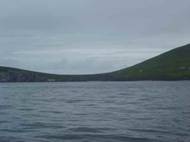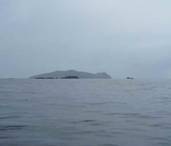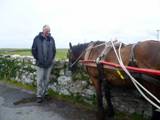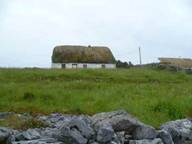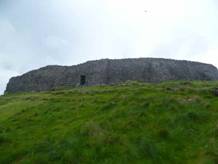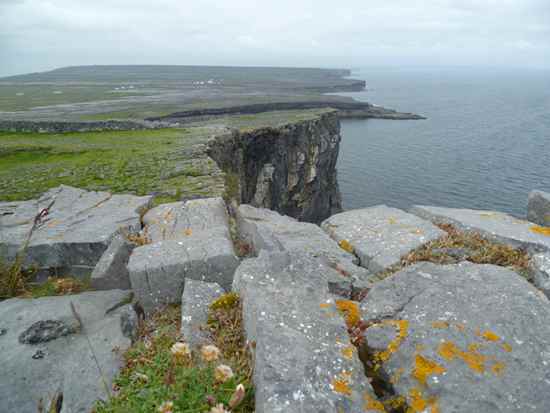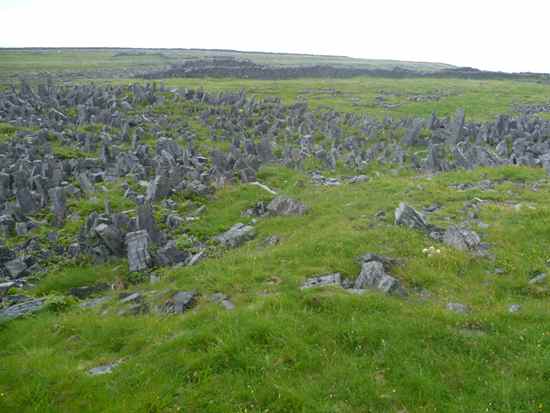Fw: The Aran Islands

|
Dingle to the Aran
Islands
The passage to Aran Island is over 80 miles and we had to motor the whole way, with the wind going all round the clock, never going above a force 2. We have done an inordinate amount of motoring on this cruise so far. It seems to be either blowing a gale so that we can’t set off at all, or else there is no wind and we have to motor. We arrived in Inishmor, the largest of the three islands, at 7.00 p.m. where we were able to pick up a visitors mooring. There was one other English boat in the harbour, and we were joined by a third yacht about an hour later. We launched the dinghy and went ashore to find out about music. We found a good band playing accordion and a strange round Celtic guitar at Joe Watty’s bar, a few hundred yards up the road from the harbour. As we were now effectively ‘on passage’ to Scotland, we only had the following morning to spend on the island, which was a shame. We made the most of it, however, and went up to the imposing iron age fort Dun Aengus, by pony and trap. We had met the owner of the ensemble the night before in the pub, and he agreed to come down to the pier to pick us up the following morning. The owner’s name was Sean, a lovely smiley old man, and the pony was called Bob Marley, who to the accompaniment of constant encouragement from Sean, carried us up the hill about three miles to the fort. It was a glorious feeling, sitting in the bouncing little trap, being ferried along the narrow winding lanes of the island.
The landscape is very strange. As we approached the islands from the south, we were struck how black they looked. The next island along, Inishmaan, looked to be almost completely black with no pasture at all. Indeed, a lot of the land is covered with sheer, dark rock. There are numerous tiny fields enclosed by random stone walls, some of the fields nearly all stone, with just a bit of grass for grazing. I noticed that the animals grazing were all cattle, no sheep. I asked Sean about this and he said that hardly anyone kept sheep any more, they were ‘too difficult’. So the wool for the Aran sweaters doesn’t come from Aran at all, but from Connemara, and indeed, he said, maybe from other places as well. I suspect that refers to the sweaters themselves as well. He pointed out a couple of cottages that were still thatched, but they were the only ones left on the island.
He also pointed out a ‘Leprechaun’s House’ in the garden of another cottage. A tiny little doll’s house of a thing, all beautifully painted in white, red and green. After that I noticed a number of these little houses. I know that only a hundred years ago, the islanders had a firm belief in the fairies, and I guess that this is a last remnant – or perhaps it’s just for the tourists – I hope not. The islanders however, do still speak Irish. We were not the only pony trap on the road that day, it is clearly a popular service to provide for tourists and as we passed other traps the owners would always stop or slow down and have a few words with their fellow drivers, in Irish. Sean said that when at home, he still spoke Irish for preference. We were completely unprepared for the ruins at Dun Aengus. They are about 2000 years old, a vast stone construction of three roughly concentric semi circles, hugely buttressed and strong. Outside these was what they called a ‘chevaux de frise’, a jumble of upright pointed stones, designed to impede the progress of any invading army. The main stone walls run right to the edge of high cliffs, and you are able to walk right to the edge and stare down into the pounding Atlantic swell below. The weather was beginning to close in as we were up there, and as we were almost the first visitors of the morning, we were able to absorb the powerful atmosphere of the site. It is difficult to imagine the energy that must have gone into building it, or indeed what actually went on there.
Back down then to meet up with Bob Marley and Sean and this time returning along the low road by the sea into town. The weather by now had turned really nasty with a persistent drizzle. We were dressed in our oily jackets, but the rain started running down onto the benches we were sitting on, and thence under our bottoms, which were not protected with waterproofs. By the time we reached the pierhead again it was absolutely pouring with rain and very cold and we were drenched to the skin. We decided to warm up in the pub, and wait for the rain to abate a bit before returning to the boat. Both other yachts had gone, and we decided to move on a few miles in order to avoid an overnight passage at some later stage. We had not seen enough of the islands and had only picked up the slightest impression of their history and heritage but we had definitely got a flavour and had above all enjoyed the people we had come across. |
